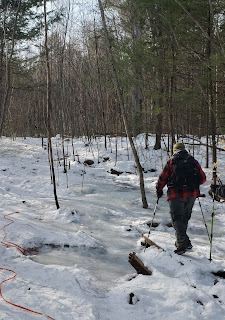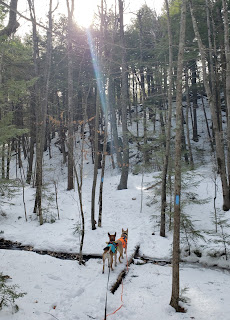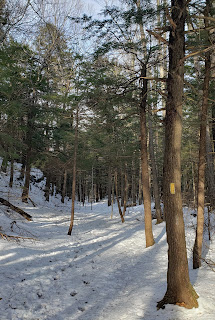I admit, no reinventing the wheel with this one but it's a post I have wanted to make for awhile: my go-to best practices for camping with dogs. And since the internet allows any ole anyone to share their two cents, I've finally gone ahead and pulled together an obnoxiously cliche five favorite strategies from the many little hacks and top tips that I've tweaked over the last nine years that have made for a more fun, less bark-y experience that I think will be applicable to others.
I wrote this list with a couple ground rules in mind: you've already decided that your pup will likely enjoy camping and, while it'll be a learning experience, they probably won't be so reactive that it's a 24-hour training session, overexcited that they're anticipating every passerby to welcome them to camp, nor any other personality feature that could use some addressing beforehand. Neither is this list meant to address etiquette/rules or safety (e.g. proof of vaccination) - it's focus is on strategies to enhance enjoyment. Finally, while I believe all of these have at least some application to a number of types of camping, we're car campers staying at developed (but not "resort") sites.
1. Select your site with care
I consider a few factors when picking a campground such as time of year, proximity to activities we enjoy and crowding (we're not fans). My girlies love hiking and swimming so we stay near extensive trail systems. We frequent WMNF campgrounds; in New Hampshire, they tend to be consistently distant from Ty's worst triggers of gunfire and fireworks. If we stay at a private campground, I'll give them a ring before booking, which also helps give me a sense of just how dog friendly they are.
In general, quiet sites tend to work best for any dog. "Quiet(er)" can translate to not near the camp host, bathrooms, dumpsters, or any other amenities - or the off season. I'm partial to sites that have built-in sight barriers like an Adirondack shelter, a thick lining of trees between sites, or that are configured such that I can park my car broadside, blocking my dogs' view of the camp road (to reduce barking/maintain tranquility).
 |
Arya's first trip, we rented an Adirondack shelter, knowing
a 360* view would be overload. Worked like a charm! |
2. A tired dog is a calm camp dog
 |
| Ahhh I'm so excited I'm nervous! |
Lessen those "ooooh something new!!" jitters (whining, pacing, barking) by arriving with an appropriately tired doggo. I find this one simple and super helpful - especially the first couple of years. Keep the calmness flowing by being prepared to run, hike, go for a drive - whatever you and your dog love to do together that tuckers them out throughout your stay. Arya is a little quicker to arrive at "bored" so I bring a couple of toys that dust off easily and throw in some micro training sessions to break up the 'hanging out' portions of camping.
3. Bring familiar gear
Does your dog have an overnight bed, such as for visits to family homes or a regularly used crate? Favorite toy or chew? The girls settle in pretty fast and I attribute much of that to the familiarity I've added to their surroundings; they know what's going on and what's expected. Just don't bring anything that can't take a little dirt!
4. Consider your containment options
Generally, dogs are required to be restrained at campgrounds and I spent many years assuming that was by leash/tie out. Only after seeing what others were doing to contain their dogs did I realize that's not the case (at least where we've stayed). For us, clipping together a few exercise pens was a game changer. Immediately, the issues with knocking over bowls, tangling around each other and equipment, and eliminating the cause of some of the defensive barking (from being restrained) made camping more enjoyable for everyone. We're lucky that our two take the pens for what they are and don't test them but I fully recognize this may not work for others - just know that tying your dog to the picnic bench isn't the only option (but if it happens to work best for you/your dog - please use a harness!). You can also buy or make an elevated runner system like
this one. Finally, if your dog is accustomed to a crate, bring one with you as well.
 |
A little tough to see but last week's layout included the two pen ends
terminating with one on each side of the back door to the car so the girls could go in and out -
since we spend a good deal of time in there, it is often their relaxation place of choice.
Working with their needs makes them happier and better behaved! |
5. Go overboard!
Admittedly, no flashy one-liner for my last strategy but I strongly recommend making a conscious effort to lay on the treats and all that good stuff. Scattering kibble, doing a loop around the campground, and extra doggy massages by the fire are all little gestures that go a long way towards ensuring our dogs are as engaged and happy with our recreation of choice as we are. (And a lot less wearisome for us than telling them to 'shush' or 'just lay down' frequently). The girls are naturally bark-y and it brings them great joy when it rains Kix cereal every time I see they've quietly noticed something worth barking at (so this one is a win-win, as it makes us better site neighbors too!).
 |
| Princess and the pea |
 |
At home, they usually take their chews outside so
hides make a naturally good camp snack! |
Hopefully you found my list useful or the items sparked new ideas! They've never failed me and our experiences continue to be smoother each time as we finesse the details!
 Taking turns on watch
Taking turns on watch





















